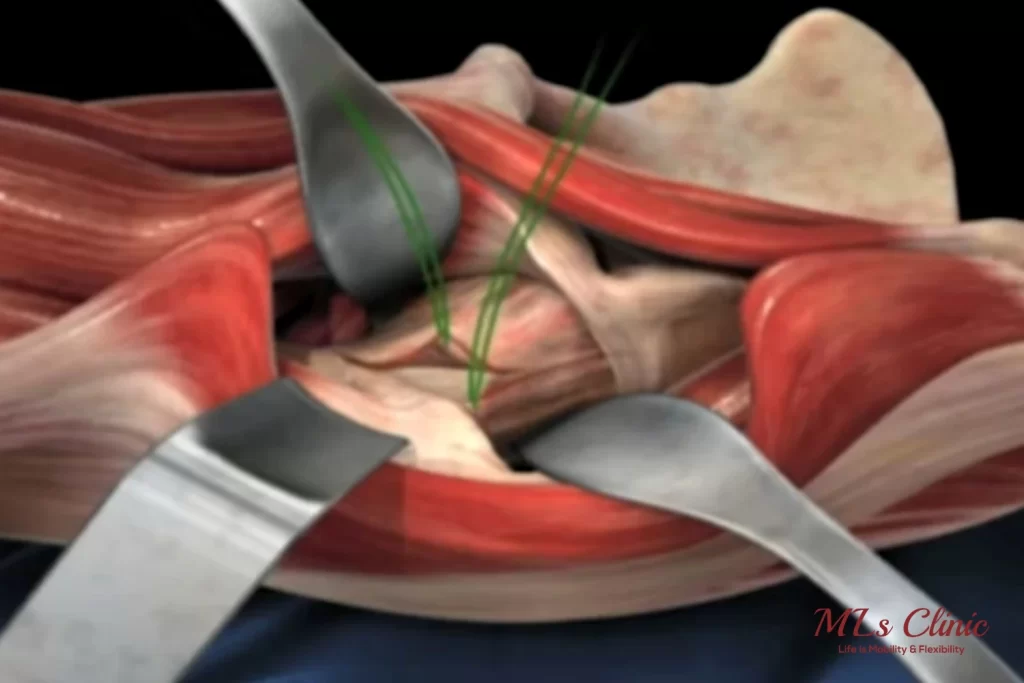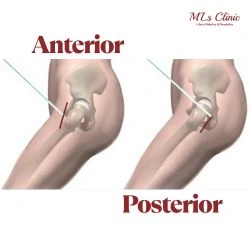Hip replacement- Direct Anterior Approach(DAA) vs MIS Posterior Approach

Have you been advised to get your hip replacement surgery done? Are you worried about which surgical approach you should opt for? Then do not worry, Dr. Preetesh Choudhary, Best Joint Replacement Surgeon in Indore, will guide you through the two common surgical approaches- Direct Anterior Approach (DAA) and MIS Posterior Approach (Minimally Invasive Surgery Posterior Approach).
Understanding Direct Anterior Approach (DAA)
The Direct Anterior Approach is a minimally invasive technique where the surgeon accesses the hip joint from the front of the hip. This method avoids cutting major muscles, allowing for faster recovery. This approach works between natural muscle planes, which means no major muscles are cut — only gently separated to reach the joint. Think of it like opening a curtain rather than cutting it.
Advantages of DAA:
- Muscle-friendly: Major muscles are spared, which means less trauma and quicker healing.
- Fast recovery: Patients start walking, sometimes even on the same day! For many, it’s “subah operation, shaam ko chalna shuru”.
- Lower risk of dislocation: Since we preserve the natural muscle and capsule support.
- Smaller incision: Less visible scar, which matters especially to younger patients.
Considerations with DAA:
- Technically Demanding: The surgeon must be specially trained in this method. It requires precision and experience.
- Equipment Needs: Often requires a specialized surgical table.
- Not Suitable for All Patients: Obese patients or those with significant hip deformities may not be ideal candidates.
Understanding Minimally Invasive Surgery Posterior Approach
This traditional method involves accessing the hip joint from the side. The femoral head (the ball of the hip joint) is dislocated towards the back (posteriorly) to allow the surgeon full access. Some muscles — particularly part of the gluteus medius — may be detached to improve visibility. Imagine you’re fixing something deep inside a room – you move some furniture (muscle) to access the area. This approach involves disruption of some of the abductor muscles and the release of the external rotators, which play a role in hip stability. Patients typically require precautions to prevent posterior hip dislocation, such as avoiding excessive hip flexion, adduction, and internal rotation, especially in the initial postoperative period. Recovery may involve a slightly longer period for muscle strengthening.
Advantages of MIS Posterior Approach:
- Wide Exposure: Offers excellent visibility of both the acetabulum (hip socket) and femur, making it suitable for complex or revision surgeries.
- Proven & Time-Tested: Used for decades with consistently successful outcomes.
- Flexible Use: Applicable in a variety of hip conditions, including cases with abnormal anatomy.
Considerations with MIS Posterior Approach:
- Muscle Cutting Required: This can prolong the recovery period and lead to temporary weakness in hip abduction (moving the leg away from the body).
- Dislocation Risk: Especially if post-op precautions are not followed, as the joint is dislocated posteriorly during surgery. There’s higher dislocation risk as compared to DAA.

Which one’s best for you?
The “best” approach isn’t universal; it depends on various factors, including:
- Surgeon Experience: Surgeon comfort and expertise with a particular approach are paramount for optimal outcomes. A surgeon less experienced with DAA might encounter challenges with exposure, leading to increased operative time or potential complications. Dr. Preetesh, Best Hip Replacement Surgeon in Indore, has extensive experience in both techniques, allowing for a tailored approach based on your specific needs.
- Patient’s Age: Mostly, young patients aged under 55, opt only for DAA as it involves minimal scarring and want to get back to work, driving, or active life sooner. MIS approach is often chosen by elderly patients who may have weaker muscles or need a more stable, traditional approach, especially if bone quality is compromised.
- Patient Anatomy: Individual variations in anatomy can sometimes make one approach more suitable than the other. The position and shape of your thigh bone are important for fitting the new hip correctly. The DAA approach helps the surgeon see this clearly during surgery, but if the thigh bone is very unusual, the MIS Posterior Approach might give the surgeon a better view. How much fat and muscle you have around your hip can also matter. Lots of belly fat can make the front approach trickier, while tight muscles on the side might make the side approach need more work.
- Previous Surgeries or Revision Cases: When a patient has undergone prior hip surgery or requires a revision procedure, the direct anterior approach is generally less favored due to the presence of scar tissue that can limit access and visibility through the front of the hip. In contrast, the MIS approach, which accesses the hip from the side, is more commonly used for these complex cases. One key advantage of the posterior approach is that, irrespective of existing scar tissue, the surgeon can still achieve a clear view of the joint. The broader surgical field allows better working space, which is especially important when removing or replacing existing implants and managing changed or distorted anatomy.
Conclusion
Both the Direct Anterior Approach (DAA) and the MIS (Minimally Invasive Surgery) Posterior Approach are safe and effective techniques for hip replacement—each with its own strengths. The best approach depends on several factors like your age, body type, muscle condition, bone anatomy, previous surgeries, and lifestyle goals. What’s most important is getting the right advice from an expert who understands you and your needs.
Why choose us?
- Expert Care, Tailored to You: Dr. Preetesh, leading orthopedic surgeon offers experienced and personalized orthopedic treatment for a wide range of conditions.
- Advanced Techniques, Optimal Results: We utilize cutting-edge methods, including specialized hip replacement approaches, for faster recovery and lasting relief.
- Trusted Expertise: With over 16 years of experience in joint and hip replacements, Dr. Preetesh provides knowledgeable guidance.
- Your Comfort, Our Priority: We focus on a seamless surgical experience and a swift recovery, helping you get back to a pain-free and active life.






